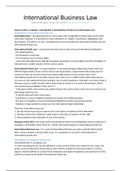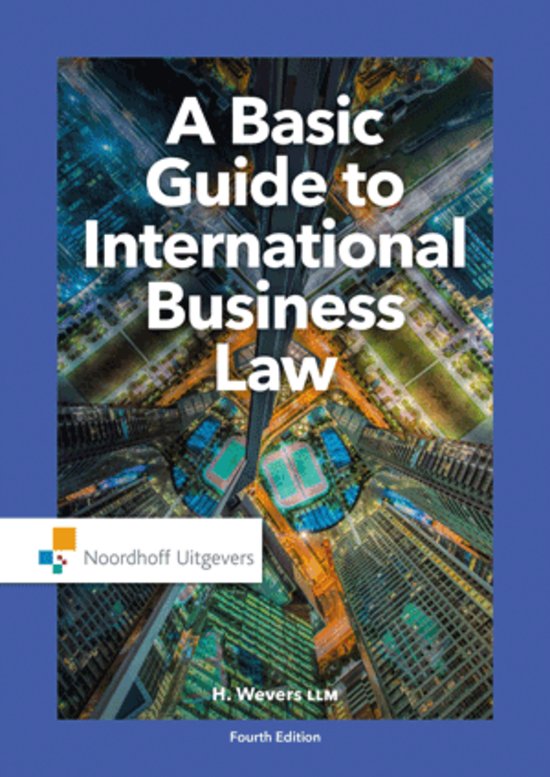International Business Law
Samenvatti ngen vanuit het boek H1,2, 8, 3, 4, 5, 6 en 7
Lecture week 4.1 Chapter 1 Introduction to Introduction Private Law and European Law
Introduction to International Private Law
International law = law agreed by two or more states and is applicable to those states and in most
cases their nationals. It is laid down in rules referred to as Treaties, Conventions, Regulations and
Declarations. The effects can vary. International law can be divided into International Public Law and
International Private Law.
International Public Law = concerned with such issues as the set-up of international institutions:
- The United Nations
- The European Community
- The European Court of Human rights
…and concerned with human right like European convention on Human Rights and the extradition of
nationals from another country to their home country.
International Private Law = to solve problems in international legal relationships which arise from
different legal systems. Every country has its own legal system, a legal relationship arising out of a
contract of sale may involve at least two national legal systems. Every country has its own
international private law. It provides a set of rules. Every act or conflict under national private law
can have an international dimension and give rise of several questions. (Example: A car driver living in
Germany causes a traffic accident with a driver living in France in a car park in Amsterdam; Which
court of law have jurisdiction in this case???).
* If the legal conflict only involves two parties living in the same country, there can be no choice over
which legal system to use.
* It need to deal with three main issues:
- Jurisdiction in cases of litigation between two parties from different states
- The law to be applied in cases of international litigation between two private parties
- Solutions to legal problems arising out of an international legal relationship
The three main pillars/issues are:
1. The private law focussing on aspects such as the place of residence of the defendant
2. The place where the employee usually works or the place of business of the seller
3. And (sometimes) the nationality of one of the parties.
European Union (EU) = the treaty on the functioning of the EU and all legislation which is based on it,
binding for all Member States of the EU. It deals with several aspects of International private law.
International Business Law = It’s a part of International Private Law and is a specific field in itself.
When various treaties covering wider areas, it is a guidance to use and it is development of
international private law.
Introduction to European Law (EU Law)
International law vs. European Law
It is also International Law, but the difference is the fact that all EU Law is based on one Treaty, the
treaty on the functioning of the European Union (TFEU), instead of numerous treaties on various
objects. Another difference is that several institutions and types of legislation are based on this TFEU,
and this is unusual in the field of International Private law.
,European Law takes precedence over the National Laws of countries that have signed the Treaty on
the functioning of the European Union (TFEU). European Law does not cover every aspect, so
national and international law still have a role to play. Main objective is to achieve economic
integration.
Art 101 and art 102 TFEU The European Commission conduct
The main objective of the EU is to achieve economic integration through the use of a common
market where goods, persons, capital and services can circulate freely. Member States make it work
to should give up their sovereignty in those areas governed by the EU Treaty.
EU Supranational organisation = It is a state above the Member States, which has the authority to
make rules that bind the Member States of the EU, without their specific and prior consent.
Supremacy of the EU Law = EU takes precedence over national law and is thus applied uniformly
throughout the EU. EU law has two types:
- Directly applicable : Means that provisions of EU Law apply directly within the legal systems of
the Member States, without the need for further facts by the government of these Member States
(Have NO control). Art. 288 TFEU Directly applicable
- Directly effective : gives rights to nationals of the EU and is only interest to nationals as it does
not in itself affect the member states. Example of provisions is a treaty article, only effect if ECJ has
said it does. Only ECJ can decide direct effect EU LAW. Art. 112 TFEU/art. 12 EC (only than rely)/Art.
267 TFEU
ECJ Direct effect criteria:
* The provision must be clear and unambiguous
* The provision must be unconditional
* The provision must take effect without further acts of the EU or Member States
Other articles ECJ has decided have a direct effect:
* Free movement of persons (Art. 45 TFEU)
* Free movement of goods (Art. 34, 35, 36 TFEU)
* Right to equal pay for men and women (Art. 157 TFEU)
* Competition law (Art. 101, 102 TFEU)
All EU nationals can enforce these articles in a national court. EU has 28 States. The EU institutions
are unique. They do not correspond other institutions. The institutions of the EU are:
* European Parliament (Art.223 – 234 TFEU)
* Council of the EU (Art. 235 – 236 TFEU)
* Council of Ministers (Art. 237 – 243 TFEU)
* European Court of Justice (Art. 251 – 281 TFEU)
Apart from the TFEU, there are several other types of legislation: regulations, directives and
decisions.
Regulations = general rules
Directives = period of time of implementations.
Decisions = are individual acts, binding on a member state or an individual (group). (commission)
European court of justice and preliminary rulings under Art. 267 TFEU. ECJ the legal right to give
preliminary rulings. (schedule 1.1)
Action for annulment under Art. 263 TFEU. (revisable acts, right to challenge, grounds for challenge,
time limits, effects of annulment.
, Lecture week 4.2 Chapter 2 Negotiations
Reaching an agreement
The content of such an agreement can be derived either from national law of an international treaty.
There is no specific written law.
Preliminary stage = The stage of negotiations, the stage prior to the final agreement between the two
parties. This chapter will provide answers to questions on the rights and obligations of the
negotiating parties during this preliminary stage. Period of time from point 1 up to point 5.
An agreement between two parties is reached when one party accepts the offer of the other. Before
an agreement is reached parties negotiate (for weeks/months) over the content of their final
agreement. In reaching an agreement, the parties have to go through several distinct procedures
Stages of making an agreement through negotiating parties:
A1 B2 3 B4 A5 6
A1 : A draws up an offer and sends it to B
B2 : The offer is delivered to B.
3 : B takes time to think things over.
B4 : B comes to a decision and sends his acceptance to A.
A5 : B’s acceptance reaches A: at the very moment B’s acceptance reaches A the agreement becomes
final.
6 : This moment is just after the moment when an agreement becomes final.
Offer/business proposal = a legal offer when:
1. An object is described (Volkswagen Golf, built in 2000)
2. A Price is determined (Selling price is €4.000 non negotiable)
3. The number of objects is stated (The object of the offer is ONE single car)
If one of these criteria is missing, there can not be an offer in legal sense. When two or more is
missing, there is a so-called invitation to enter into negotiations is given to another party.
Valid offer = An offer what is reached the other party the offeree, B. “reception theory”. No matter
when actually reads. Final agreement: they have reached and an acceptance.
Withdraw = The offer is in time and the offerer prevents the offer from actually becoming a valid
offer. After withdrawing the offer in time, an offer no longer exists. Withdrawn is data of receive.
Offer in time. Example: On 6 May sends an offer which has drawn up on 4 May. Receives the offer on
9 May and reads the offer on 12 May. The offer becomes valid on 9 May.
No withdrawn : there is no time for thinking about the offer. There is no period of time mentioned in
the offer. It has to be accepted immediately or else it would no longer exist in a legal sense. The
period will be depends on the object (house/book) and also on the person (experience).
Revoke/revoking an offer = Require A would inform B that he is no longer interested in selling goods
to B and that he therefore withdrawns his valid offer. Revoke an offer is not possible in certain
circumstances: when the offer is already accepted (after point 4: where B sends his acceptance) and
when the offer is irrevocable.
Counter offer = A new offer from B to A. B is making this!! Only when A’s first offer no longer legally
exists. Example : coming up with further requirements, these are different from the original offer and
so a new offer. You will start at point 1.






